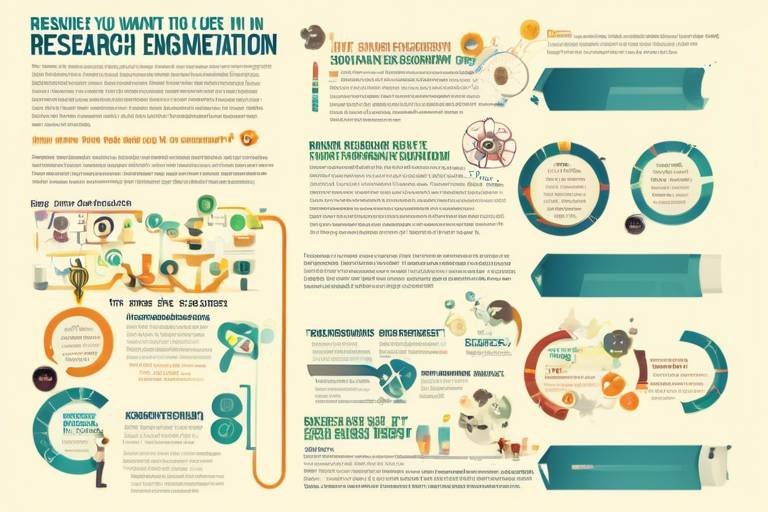How to Use Think-Aloud Protocols in User Experience Studies
In the ever-evolving world of user experience (UX) research, think-aloud protocols have emerged as a powerful tool for understanding how users interact with products. Imagine sitting down with a user as they navigate through your website or app, and instead of just observing their actions, you can actually hear their thoughts as they unfold. This method not only sheds light on users' cognitive processes but also provides researchers with invaluable insights that can inform design decisions. In this article, we will explore the implementation of think-aloud protocols in user experience studies, detailing their benefits, challenges, and best practices for effective application.
Think-aloud protocols involve participants verbalizing their thoughts while interacting with a product. This technique traces its origins back to cognitive psychology, where researchers sought to understand the mental processes involved in problem-solving and decision-making. By encouraging users to articulate their thoughts, researchers gain a deeper understanding of user behavior during usability testing. It's like opening a window into the user’s mind, allowing us to see beyond mere actions to the motivations and feelings that drive those actions. This method is particularly relevant in today's UX landscape, where understanding user behavior is crucial for creating products that resonate with their target audience.
Using think-aloud protocols offers a multitude of advantages that can significantly enhance the quality of user experience research. One of the most notable benefits is the ability to gain insights into user cognition. When participants express their thoughts, researchers can uncover motivations and pain points that might not be visible through observation alone. This process not only helps in identifying usability issues but also enhances the overall user experience through real-time feedback.
By capturing users' thoughts, researchers can delve into the underlying reasons behind their actions. For example, a user might struggle with a particular feature, and their verbalization could reveal that they find it confusing due to unclear labeling. These insights lead to better design decisions, allowing teams to address specific user needs effectively. In essence, think-aloud protocols turn users into co-designers, providing a rich narrative that guides the design process.
One of the most dynamic aspects of think-aloud protocols is the opportunity for real-time feedback. Imagine a researcher observing a user who becomes frustrated with a specific interaction. With think-aloud protocols, the researcher can immediately ask follow-up questions, clarifying the user's experience and addressing issues on the spot. This immediate interaction not only contributes to more effective user-centered design but also fosters a collaborative atmosphere where users feel their opinions are valued.
Think-aloud protocols are particularly effective in pinpointing specific usability challenges users face. By analyzing the verbalizations, researchers can categorize issues based on frequency and severity. For example, if multiple users express confusion over a navigation element, it signals a need for redesign. Various methods, such as thematic analysis or coding, can be employed to analyze these verbal data, leading to actionable insights that inform product improvement. The implications are clear: addressing usability issues early in the design process can save time and resources down the line.
While think-aloud protocols are beneficial, implementing them does present challenges. One common obstacle is participant discomfort. Not everyone is accustomed to verbalizing their thoughts, and some may feel self-conscious or unsure about what to say. This discomfort can lead to incomplete or biased data collection, ultimately affecting the study's outcomes. Additionally, there is the potential for participants to alter their behavior because they know they are being observed, which can skew results. Researchers must be prepared to navigate these challenges to ensure the integrity of their data.
To maximize the effectiveness of think-aloud protocols, certain best practices should be followed. These strategies encompass preparing participants, setting up the environment, and ensuring clear instructions. Each step is crucial in creating a conducive atmosphere for open communication and genuine feedback.
Preparing participants is essential for successful think-aloud studies. Techniques such as familiarizing participants with the process and providing examples of what to verbalize can ease them into the experience. Encouraging natural verbalization of thoughts can significantly enhance the richness of the data collected. For instance, researchers might use prompts like, "What are you thinking right now?" or "Can you explain why you chose that option?" to guide participants.
A comfortable testing environment can significantly impact participant performance. Designing a space that minimizes distractions, such as noise or visual clutter, promotes open communication during the study. Consider using comfortable seating, adequate lighting, and a friendly atmosphere to help participants feel at ease. Remember, the goal is to make them feel as comfortable as possible so they can express their thoughts freely.
- What is a think-aloud protocol? - It is a research method where participants verbalize their thoughts while interacting with a product, providing insights into their cognitive processes.
- How can think-aloud protocols improve user experience? - They help identify usability issues and enhance design decisions by capturing real-time user feedback.
- What challenges might I face when implementing this method? - Common challenges include participant discomfort and potential biases in data collection.

Understanding Think-Aloud Protocols
Think-aloud protocols are a fascinating and powerful method used in user experience (UX) research, where participants verbalize their thoughts and feelings while interacting with a product or interface. Imagine sitting in front of a user testing a new app, and instead of just observing their actions, you can actually hear their inner dialogue as they navigate through the features. This technique allows researchers to gain a deeper understanding of user behavior, motivations, and frustrations, providing invaluable insights that can guide design improvements.
The origins of think-aloud protocols can be traced back to cognitive psychology, where researchers sought to understand the mental processes behind decision-making. Over the years, this method has evolved and found its way into the realm of UX research, becoming an essential tool for usability testing. By encouraging participants to articulate their thoughts, researchers can capture real-time feedback and identify usability issues that might otherwise go unnoticed. It's like having a window into the user's mind, revealing the thought processes that drive their actions.
In the context of usability testing, think-aloud protocols are particularly relevant. They help bridge the gap between user actions and the underlying cognitive processes. When users verbalize their thoughts, they provide context to their behaviors, which is crucial in understanding why they may struggle with certain tasks or features. For example, if a user expresses confusion while trying to find a button, that verbal cue can lead researchers to reconsider the design's clarity and accessibility.
Moreover, think-aloud protocols can be applied in various UX studies, ranging from website usability tests to mobile app evaluations. The flexibility of this method allows researchers to adapt it to different contexts and objectives. However, it’s important to note that the effectiveness of think-aloud protocols hinges on the participants' comfort level and willingness to share their thoughts openly. Therefore, creating a supportive environment is essential for maximizing the benefits of this technique.
In summary, think-aloud protocols are a vital component of user experience research, offering a unique perspective on user behavior and cognition. By encouraging participants to vocalize their thoughts, researchers can uncover insights that lead to better design decisions and ultimately enhance the user experience. As we delve deeper into the benefits of using think-aloud protocols, it becomes clear that this method not only enriches the research process but also empowers designers to create more user-centered products.

Benefits of Think-Aloud Protocols
Think-aloud protocols are like unlocking a treasure chest of insights when it comes to understanding user experience. Imagine having a direct line into the minds of users as they navigate through your product. This method allows researchers to hear the thoughts, feelings, and reactions of users in real-time, offering a unique perspective that is often missed in traditional usability testing. By verbalizing their thoughts, users provide a rich narrative that reveals their motivations and frustrations, which can be invaluable for making informed design decisions.
One of the most significant advantages of using think-aloud protocols is the ability to gather enhanced user insights. When users articulate their thoughts, researchers can identify not just what users are doing, but why they are doing it. This deeper understanding helps in pinpointing specific pain points that may not be observable through mere observation. For instance, if a user struggles to find a feature, their verbalization might reveal underlying assumptions or misconceptions about the product. This kind of feedback is gold for designers, as it directly informs the iterative design process.
Another compelling benefit is the provision of real-time feedback. Think about the last time you tried to fix something while it was happening. The ability to make adjustments on the fly can dramatically improve outcomes. In think-aloud studies, researchers can address usability issues as they arise, leading to immediate enhancements in the user experience. This dynamic interaction not only helps in refining the product during the testing phase but also fosters a more user-centered design approach overall.
Moreover, think-aloud protocols are instrumental in the identification of usability issues. By having users vocalize their thoughts, researchers can systematically analyze the data collected to pinpoint specific challenges faced during the interaction. For example, if multiple users express confusion about a navigation element, it signals a broader usability concern that needs to be addressed. The table below summarizes common usability issues identified through think-aloud protocols:
| Usability Issue | Description | Potential Solutions |
|---|---|---|
| Confusing Navigation | Users struggle to find key features. | Redesign navigation layout, improve labeling. |
| Inconsistent Terminology | Users misunderstand terms used in the interface. | Standardize language across the product. |
| Slow Response Time | Users express frustration over lagging interactions. | Optimize performance and speed. |
In conclusion, think-aloud protocols serve as a powerful tool in the arsenal of user experience research. They not only provide a window into user cognition but also offer a platform for immediate feedback and usability issue identification. By leveraging these benefits, designers can create more intuitive and user-friendly products that resonate with their target audience.
Q: What is a think-aloud protocol?
A: A think-aloud protocol is a research method where participants verbalize their thoughts while interacting with a product, allowing researchers to gain insights into user behavior and experience.
Q: How do think-aloud protocols improve user experience?
A: They provide real-time feedback and insights that help identify usability issues, enabling designers to make informed decisions that enhance the overall user experience.
Q: Are there any challenges in using think-aloud protocols?
A: Yes, challenges include participant discomfort and the potential for biased data collection, which researchers need to manage carefully.
Q: What are some best practices for conducting think-aloud studies?
A: Best practices include preparing participants adequately, creating a comfortable testing environment, and providing clear instructions to encourage natural verbalization of thoughts.

Enhanced User Insights
Think-aloud protocols serve as a powerful tool in the realm of user experience (UX) research, offering a unique window into the minds of users. When participants articulate their thoughts while navigating a product, researchers gain access to a wealth of valuable insights that might otherwise remain hidden. Imagine trying to solve a puzzle without seeing the pieces; that's often how UX designers feel without this critical feedback. By listening to users as they interact with a product, researchers can identify not only what users are doing but also why they are making those choices.
One of the most significant advantages of think-aloud protocols is the ability to uncover users' motivations and pain points. For instance, during a usability test of a mobile app, a participant might express frustration with a confusing navigation menu. This verbalization not only highlights a specific usability issue but also reveals the underlying emotions associated with that experience. Such insights can lead to more informed design decisions, ultimately enhancing the overall user experience.
Moreover, think-aloud protocols allow researchers to capture the thought processes that guide user interactions. For example, a user might state, "I thought I needed to click here because it looks like a button," indicating a potential design flaw where visual cues are misleading. This type of feedback is invaluable, as it enables designers to refine their products based on real user experiences rather than assumptions.
To further illustrate the impact of think-aloud protocols, consider the following table that summarizes common insights gained from this method:
| Insight Type | Description |
|---|---|
| User Motivations | Understanding what drives users to make specific choices during their interaction. |
| Identified Pain Points | Spotting areas of confusion or frustration that hinder the user experience. |
| Thought Processes | Gaining insight into how users approach tasks and the logic behind their actions. |
| Emotional Responses | Recognizing users' feelings towards different aspects of the product. |
In essence, think-aloud protocols transform the user experience research landscape by providing a more holistic view of user interactions. By allowing users to voice their thoughts, researchers can gather richer data that leads to improved designs. This method not only enhances the understanding of user behavior but also fosters a more user-centered approach to product development.
- What are think-aloud protocols? Think-aloud protocols involve participants verbalizing their thoughts while interacting with a product, providing insights into their cognitive processes.
- Why are they important in UX research? They help uncover user motivations, pain points, and thought processes, leading to better design decisions.
- What challenges might arise when using this method? Participants may feel uncomfortable verbalizing their thoughts, which can lead to biased data collection.
- How can I prepare participants for think-aloud studies? It's essential to explain the process clearly and encourage them to speak naturally about their thoughts and feelings.

Real-Time Feedback
Real-time feedback is like having a conversation with a friend while playing a video game—you're not just focused on the game; you’re also sharing your thoughts and feelings about it. In the context of think-aloud protocols, this dynamic interaction allows researchers to capture users' immediate reactions and thoughts as they navigate through a product. Imagine being able to tweak a design on the fly based on what users are saying in the moment! This immediacy not only enhances the research process but also empowers designers to make informed decisions that can lead to a more user-centered product.
One of the most exciting aspects of real-time feedback is that it creates a loop of communication between the user and the researcher. When users verbalize their thoughts, researchers can ask follow-up questions to dive deeper into specific issues or observations. For instance, if a user expresses frustration about a confusing button, the researcher can immediately probe further: “What makes it confusing for you?” This type of inquiry can uncover insights that might otherwise be missed in a traditional post-test interview.
Furthermore, real-time feedback can significantly reduce the time spent on the analysis phase of a study. Instead of waiting until after the session to assess usability problems, researchers can address issues as they arise. This proactive approach means that adjustments can be made instantly, allowing for an iterative design process that is responsive to user needs. Think of it as having a safety net—if something goes wrong, you can catch it before it spirals into a larger issue.
However, to maximize the benefits of real-time feedback, researchers must create an environment that encourages open dialogue. A comfortable setting where participants feel at ease to express their thoughts is crucial. This can be achieved by providing clear instructions and reassurance, letting them know that their honest feedback is invaluable. By fostering this atmosphere, participants are more likely to share their thoughts freely, leading to richer data and a more fruitful study.
In conclusion, real-time feedback in think-aloud protocols is a game changer. It transforms the user experience research landscape by enabling immediate insights and adjustments. By embracing this approach, researchers can ensure that they are not just observing users but engaging with them in a meaningful way, ultimately leading to designs that resonate with real user needs.
- What are think-aloud protocols? Think-aloud protocols are research methods where participants verbalize their thoughts while interacting with a product, providing insights into their cognitive processes.
- How does real-time feedback improve user experience research? Real-time feedback allows researchers to address usability issues immediately, making adjustments that enhance the overall user experience during the study.
- What challenges might arise when implementing think-aloud protocols? Common challenges include participant discomfort with verbalizing thoughts and the potential for biased data collection due to the presence of researchers.
- How can researchers prepare participants for think-aloud studies? Researchers can prepare participants by explaining the process clearly, providing examples of think-aloud statements, and reassuring them that there are no right or wrong answers.

Identification of Usability Issues
When it comes to creating user-friendly products, identifying usability issues is a fundamental step that can make or break the user experience. Think-aloud protocols shine in this area, offering a unique lens through which researchers can observe users as they navigate a product. Imagine watching someone try to solve a puzzle while hearing their thoughts—this is the essence of think-aloud protocols. As users articulate their thoughts, researchers can pinpoint specific challenges that users encounter, giving invaluable insights into the usability of the product.
One of the key advantages of think-aloud protocols is their ability to reveal real-time frustrations that might otherwise go unnoticed. For instance, if a user struggles to find a button or feels confused by a feature, their verbalizations can highlight these pain points. This immediate feedback is crucial because it allows designers to understand not just what users are doing, but *why* they are struggling. It’s like having a conversation with a friend who’s trying to navigate a new city; their reactions and comments can guide you to improve the map you’re providing.
To analyze usability issues effectively, researchers often employ various methods such as coding user comments into themes or categories. This involves listening to the recorded sessions and identifying recurring issues or trends. For example, if multiple users express confusion about a particular navigation path, it becomes evident that a redesign may be necessary. Here’s a simple table that outlines some common usability issues and their potential impacts:
| Usability Issue | Description | Impact on User Experience |
|---|---|---|
| Confusing Navigation | Users struggle to locate key features or information. | Increased frustration and potential abandonment of the product. |
| Inconsistent Terminology | Different terms are used for similar functions. | Users may feel lost and unsure of how to proceed. |
| Slow Response Times | Users experience delays when interacting with the interface. | Can lead to impatience and dissatisfaction with the product. |
Additionally, think-aloud protocols can facilitate discussions around user expectations versus reality. When users verbalize their initial assumptions about how a feature should work, researchers can compare this with their actual experiences. This gap can indicate where user education or interface adjustments are necessary. In essence, it’s like tuning into a frequency that reveals the hidden struggles of your users, allowing you to harmonize your product with their needs.
Ultimately, the identification of usability issues through think-aloud protocols not only helps in refining the product but also fosters a deeper understanding of the user’s journey. By actively engaging with users and capturing their thoughts in real-time, researchers can create a feedback loop that continuously informs design improvements. This iterative process is essential for developing products that not only meet user expectations but also delight them, creating a memorable experience that keeps them coming back for more.
- What are think-aloud protocols? - Think-aloud protocols involve participants verbalizing their thoughts while interacting with a product, providing insights into their cognitive processes.
- How do think-aloud protocols help identify usability issues? - By capturing users’ real-time thoughts and frustrations, researchers can pinpoint specific challenges that users face during their interactions.
- What methods can be used to analyze think-aloud data? - Common methods include thematic coding, identifying recurring issues, and comparing user expectations with actual experiences.
- Are there any challenges in implementing think-aloud protocols? - Yes, challenges can include participant discomfort and potential biases in data collection.

Challenges in Implementation
Implementing think-aloud protocols in user experience studies can be a double-edged sword. While these techniques can yield profound insights into user behavior, they also come with a set of challenges that researchers must navigate. One of the most significant hurdles is participant discomfort. Imagine being asked to narrate your thoughts while trying to focus on a task—this can feel overwhelming for many. Participants may struggle to articulate their thoughts clearly or may become self-conscious, leading to less authentic responses. This discomfort can skew the data collected, making it less reliable.
Moreover, the potential for biased data collection is another challenge. When participants are aware that they are being observed and recorded, they might alter their behavior. This phenomenon, known as the Hawthorne effect, can lead to responses that are not entirely genuine. For instance, a user might express satisfaction with a product they actually find frustrating, simply because they want to appear competent or because they fear judgment. This can create a gap between what users say and what they truly think, complicating the analysis.
Additionally, the complexity of analyzing the verbal data gathered during think-aloud sessions can be daunting. Researchers need to sift through a wealth of information to identify meaningful patterns and insights. This process often requires advanced skills in qualitative analysis, which not all UX researchers possess. Without proper training, there’s a risk of overlooking critical insights or misinterpreting user feedback.
To summarize, the challenges of implementing think-aloud protocols can be categorized into three main areas:
- Participant Discomfort: Users may feel uneasy verbalizing their thoughts, leading to inauthentic data.
- Biased Behavior: Awareness of being observed can alter a participant's natural behavior, affecting the validity of the findings.
- Data Analysis Complexity: The sheer volume of verbal data can overwhelm researchers, making it challenging to extract actionable insights.
Despite these challenges, many researchers find that the benefits of think-aloud protocols outweigh the drawbacks. By being aware of these issues, researchers can take proactive steps to mitigate them, ensuring that their findings are both reliable and impactful. This might include conducting preliminary sessions to help participants get comfortable or employing trained moderators to facilitate the process. Ultimately, understanding these challenges is crucial for anyone looking to harness the power of think-aloud protocols effectively.
- What are think-aloud protocols? Think-aloud protocols are methods where participants verbalize their thoughts while interacting with a product, providing insights into their cognitive processes.
- Why are think-aloud protocols useful in UX research? They help researchers gain deeper insights into user behavior, motivations, and pain points that might not be visible through observation alone.
- How can I reduce participant discomfort during think-aloud sessions? Preparing participants with clear instructions, conducting warm-up tasks, and creating a relaxed environment can help ease discomfort.
- What are some common biases to watch out for? The Hawthorne effect, where participants change their behavior due to being observed, is a significant bias to consider.

Best Practices for Conducting Studies
When it comes to implementing think-aloud protocols in user experience studies, following best practices can dramatically enhance the quality of your findings. First and foremost, it’s essential to prepare your participants adequately. You want them to feel comfortable and confident as they verbalize their thoughts. This preparation might include a brief introduction to the study, explaining what think-aloud protocols entail, and reassuring them that there are no right or wrong answers. The goal is to create an environment where they feel free to express their genuine thoughts and feelings.
In addition to participant preparation, the physical environment where the study takes place plays a crucial role. A comfortable and distraction-free setting can significantly impact participant performance. Consider factors such as lighting, seating arrangements, and noise levels. You might want to use soundproofing materials or conduct the study in a quiet room to ensure that participants can focus entirely on the task at hand without external disturbances.
Moreover, providing clear and concise instructions is vital. Participants should know exactly what is expected of them. You can achieve this by using a script that outlines the study's objectives and details the think-aloud process. This script can include prompts to encourage participants to share their thoughts, such as “What are you thinking right now?” or “Can you explain why you chose that option?” These prompts help keep the dialogue flowing and ensure that the participants remain engaged throughout the study.
Another best practice is to conduct a pilot study before the actual research. This preliminary step allows you to identify potential issues and make necessary adjustments to your methodology. It’s like a dress rehearsal before the big show, where you can iron out any wrinkles in your approach. Additionally, consider recording the sessions (with participants' consent) to analyze the data later. This can provide valuable insights that you might miss during the live session.
Lastly, always be open to feedback from participants after the study. This can be an informal conversation where you ask them about their experience and any difficulties they encountered while verbalizing their thoughts. Their feedback can be a goldmine for refining your approach in future studies.
- What is the main purpose of think-aloud protocols?
Think-aloud protocols aim to gain insights into users' cognitive processes while they interact with a product, helping researchers understand their motivations and pain points. - How can I prepare participants for a think-aloud study?
Preparation includes explaining the process, reassuring them about the absence of right or wrong answers, and encouraging them to speak freely about their thoughts. - What should I consider when setting up the testing environment?
Ensure the environment is comfortable, quiet, and free from distractions, with appropriate seating and lighting to help participants focus. - Is it necessary to conduct a pilot study?
Yes, a pilot study helps identify potential issues and allows researchers to refine their methodology before the main study.

Participant Preparation
Preparing participants for think-aloud protocols is a crucial step that can significantly influence the quality of the data collected during user experience studies. When participants feel comfortable and understand what is expected of them, they are more likely to provide authentic and insightful verbalizations of their thoughts. To kick things off, it's essential to create a warm and welcoming atmosphere. Think of it like inviting someone into your home; the more comfortable they feel, the more open they will be.
Start by explaining the purpose of the study. Participants should know that their insights are invaluable for improving the product or service they are testing. This not only helps them feel important but also encourages them to share their thoughts more freely. A common misconception is that participants need to be experts in the product being tested. In reality, it's often more beneficial to have a diverse group of users, including those who may not be familiar with the product. This can lead to a richer variety of feedback and insights.
Another key aspect of participant preparation is to give clear instructions. Make sure to articulate what you mean by "thinking aloud." Encourage participants to verbalize not just their actions, but also their feelings, thoughts, and any hesitations they encounter. To facilitate this, consider using prompts such as:
- “What are you thinking right now?”
- “Can you explain why you chose that option?”
- “How does this feature make you feel?”
It's equally important to conduct a practice run. This allows participants to get a feel for the process without the pressure of being recorded. During this practice, you can observe their comfort level and make necessary adjustments. Additionally, reassure them that there are no right or wrong answers. The goal is to gather genuine feedback, and participants should feel free to express their thoughts openly.
Lastly, consider the psychological aspect of participant preparation. Some individuals may feel self-conscious about speaking their thoughts aloud, especially in a testing environment. To alleviate this discomfort, remind them that their input is valuable and that many people share similar feelings when placed in a testing scenario. By addressing these concerns upfront, you can foster a more relaxed atmosphere that encourages genuine interaction.
In summary, effective participant preparation involves creating a welcoming environment, providing clear instructions, conducting practice runs, and addressing any psychological barriers. By investing time and effort into this preparation phase, researchers can enhance the quality of the data collected, leading to more meaningful insights and ultimately better user experiences.
- What is the main goal of using think-aloud protocols?
The main goal is to gain insights into user cognition and identify usability issues as users interact with a product. - How can I make participants feel comfortable?
Creating a welcoming environment, explaining the study's purpose, and assuring them that their feedback is valuable can help ease their discomfort. - What should I do if a participant struggles to verbalize their thoughts?
Use prompts to encourage them, and consider conducting a practice run to help them get accustomed to the process. - Are there any specific instructions I should give participants?
Instruct them to verbalize their actions, thoughts, feelings, and any hesitations they encounter while using the product.

Creating a Comfortable Environment
When it comes to conducting think-aloud protocols in user experience studies, the environment where the research takes place can play a pivotal role in the outcomes. Imagine trying to share your thoughts while sitting in a noisy café or a cramped room—it's nearly impossible to focus! Therefore, creating a comfortable and conducive testing environment is essential for eliciting genuine feedback from participants.
First off, the physical layout of the space should be inviting and free from distractions. A well-organized area can significantly enhance participants' comfort levels, allowing them to concentrate on the task at hand. Consider the following aspects when setting up the environment:
- Lighting: Ensure the space is well-lit, but avoid harsh fluorescent lights that can create a clinical feel. Natural light is ideal, as it can help participants feel more relaxed.
- Seating: Provide comfortable seating arrangements. A cozy chair can make a huge difference in how at ease a participant feels during the session.
- Noise Levels: Minimize background noise. If possible, conduct sessions in a quiet room or use soundproofing techniques to block out distractions.
Moreover, it's important to consider the emotional atmosphere of the environment. Participants are more likely to open up and share their thoughts if they feel welcomed and valued. Here are some strategies to foster a positive emotional climate:
- Warm Greetings: Start with a friendly introduction. Make sure to explain the purpose of the study and how their input is invaluable.
- Personal Touches: Consider adding small elements like refreshments or comfortable items (like cushions) that can make the space feel more homely.
- Encouragement: Regularly reassure participants that their thoughts are important and that there are no right or wrong answers. This can help alleviate any pressure they might feel.
Another crucial factor is the technology setup. Ensure that all necessary equipment works seamlessly. Technical difficulties can cause frustration and disrupt the flow of thought. Test all devices beforehand, and have a backup plan in case something goes awry. A smoothly functioning setup allows participants to focus on their thoughts rather than technical issues.
Finally, don’t forget about the timing of the sessions. Schedule them at times when participants are likely to be at their best—avoid early mornings or late afternoons when fatigue sets in. A well-timed session can lead to richer insights and a more engaging experience for everyone involved.
In conclusion, creating a comfortable environment for think-aloud protocols is about more than just physical comfort; it’s about fostering a space where participants feel valued and at ease. By focusing on the physical, emotional, and technical aspects of the environment, researchers can significantly enhance the quality of the feedback received, leading to more meaningful insights into user experience.
- What are think-aloud protocols? Think-aloud protocols involve participants verbalizing their thoughts while interacting with a product, providing insights into their cognitive processes.
- Why is the environment important in UX studies? A comfortable environment minimizes distractions and encourages participants to share their genuine thoughts, leading to more valuable data.
- How can I ensure participants feel comfortable? Warm greetings, a friendly atmosphere, and comfortable seating can all contribute to making participants feel at ease.
- What should I do if technical issues arise during the study? Always have a backup plan and test your equipment beforehand to minimize disruptions during the session.
Frequently Asked Questions
- What are think-aloud protocols?
Think-aloud protocols are a research method where participants verbalize their thoughts while interacting with a product. This technique helps researchers understand user behavior and cognition during usability testing, providing valuable insights into the user experience.
- What are the main benefits of using think-aloud protocols?
Using think-aloud protocols offers several advantages, including enhanced user insights, real-time feedback, and the identification of usability issues. By capturing users' thoughts, researchers can uncover motivations and pain points that may not be visible through observation alone, leading to better design decisions.
- Are there any challenges associated with think-aloud protocols?
Yes, implementing think-aloud protocols can present challenges such as participant discomfort and potential bias in data collection. Some participants may struggle to articulate their thoughts while using a product, which can affect the quality of the data collected.
- How can I prepare participants for think-aloud studies?
Preparing participants is crucial for successful think-aloud studies. Techniques include providing clear instructions, explaining the importance of verbalizing thoughts, and conducting practice sessions to help them feel comfortable with the process.
- What is the best environment for conducting think-aloud studies?
A comfortable testing environment significantly impacts participant performance. It's essential to design a space that minimizes distractions and promotes open communication, allowing participants to focus on their tasks without feeling self-conscious.



















